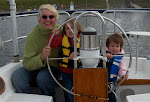 |
The indigo plant native to Ossabaw Island... Seed pods are banana shaped.
It's been on Ossabaw for over 270 years adapting to .the weather |
When I saw that the Ossabaw Island Foundation was holding an indigo dye day on the island... I said to myself... Why not have a special day for our Fiber Guild of the Savannahs! I contacted the workshop provider, Donna Hardy of Sea Island Indigo and we were off and running. I contacted The Ossabaw Island Foundation and learned that in addition to their $30day rate, we needed to find and hire someone to transport us to the island by boat. We had hoped to accommodate 24 participants (as it turned out... Twelve was PERFECT!) but I soon found out a pontoon boat that would transport all of us at once was far too expensive. We settled for a 6 passenger boat with captain Joel Formsby of Walks on Wassaw and after two trips we were all safely on the island. How delightful to be out on the water on a lovely, sunny day! (Sea Island Indigo on Facebook.)
 |
| Elizabeth telling our guild about Ossabaw |
We were greeted on the island by Elizabeth DuBose who shared some of the islands history of which Indigo played a prominent part. Indigofera suffruticosa grows right by the guest cottage and has adapted to the climate. Ossabaw means Land of the Yopawn Tea that males only would drink to purge. Ossabaw will be owned by the state of Georgia when the sole surviving inhabitant, 101 year old Mrs West passes away. She lives here alone with her caretakers and the wild hogs and sea turtles and birds and Jerusalem donkeys, and all sorts of wonderful natural inhabitants. The Foundation facilitates visitors to the island and we set up show and 4 dye vats outside of their cottage where you can make arrangements to stay overnight... (Maybe next time!)
 |
| Donna adding to the vat |
After a short walk from the dock we met our fearless well informed teacher/mentor Donna Hardy... Of course, dressed in blue... A lovely cotton top she had handsewn and indigo dyed! Donna explained that she had prepared two cellulose vats (in large plastic garbage pails) and two protein vats. We were to dye our cotton,linen and plant fibers in the cellulose and our wool, alpaca, silks, etc in the protein vat. It is important to add as little oxygen (air) to the vat as possible, so Donna showed us how to gently submerge what we wanted to dye slowly rotating it for about 30 seconds and then move it to the side of the vat to SLOWLY without adding bubbles raise it out of the water to ring it in a small tub she had placed to the side of the dye vat. then we moved to a common large garbage pail of water to rinse the fiber and watch the magic happen.... Yellow green to teal to a wonderful shade of blue. The trick is to build up layers until you achieve your desired blue...Which will probably dry lighter.
To make the vats, Donna arrived on the island the night before. Early inhabitants cut the indigo leaves and soaked them in 16 foot long vats. The smell was horrible. the vat was adjusted with lime from burnt oyster shells.The indigoten congeals and goes to the bototm of the vat like mud. It congeals and is cut up like soap. In 1782 there was a raid by the Loyalists and 30 slaves and all of the indigo cake was taken; the plants were burned.
Three things are needed to make indigo... 1. The absence of oxygen 2. The proper PH and 3. The proper temperature. Fermentation uses up the oxygen. Sodium hydrosulfite is a reducing agent. Dyeing sources for indigo are only found in India, China, Guatemala and El Salvador. Indigo will not bond to the fibers the presence of oxygen. Protein needs to be 10.2ph and cellulose need to be 11ph.
 |
| The Jerusalem donkeys, native to Ossabaw Island, try to help Betsy unpack her goodies and especially her lunch! |
 |
| First its yellow green... |
|
|
 |
| then its teal... |
 |
| ...and soon it become beautiful indigo blue! Magic! |
 |
The Ossabaw Island Jerusalem donkeys... So named for the white crosses on their backs.
 |
| This is what happens when you dye without rubber gloves! |
|
The work was not done when we
left the island after a wonderful day. We were instructed to take our
dyed things home and let them air dry. Then we were to wash the protein
fibers with Mrs. Meyers lavendar dishwashing soap or another soap NOT
detergent. (Note: Woolite is horrible for the environment.) Donna
also told us to add about 2 cups of white vinegar to a rinse to bring
the hp back.
 |
| My stash drying in my bathroom... wool rovings and cotton sliver to spin, silk chiffon to nuno felt on, several old faded garments and three handwoven pieces... a hat, a scarf and a top. My paper straw hat is out of the picture, but its now indigo blue too! |




























